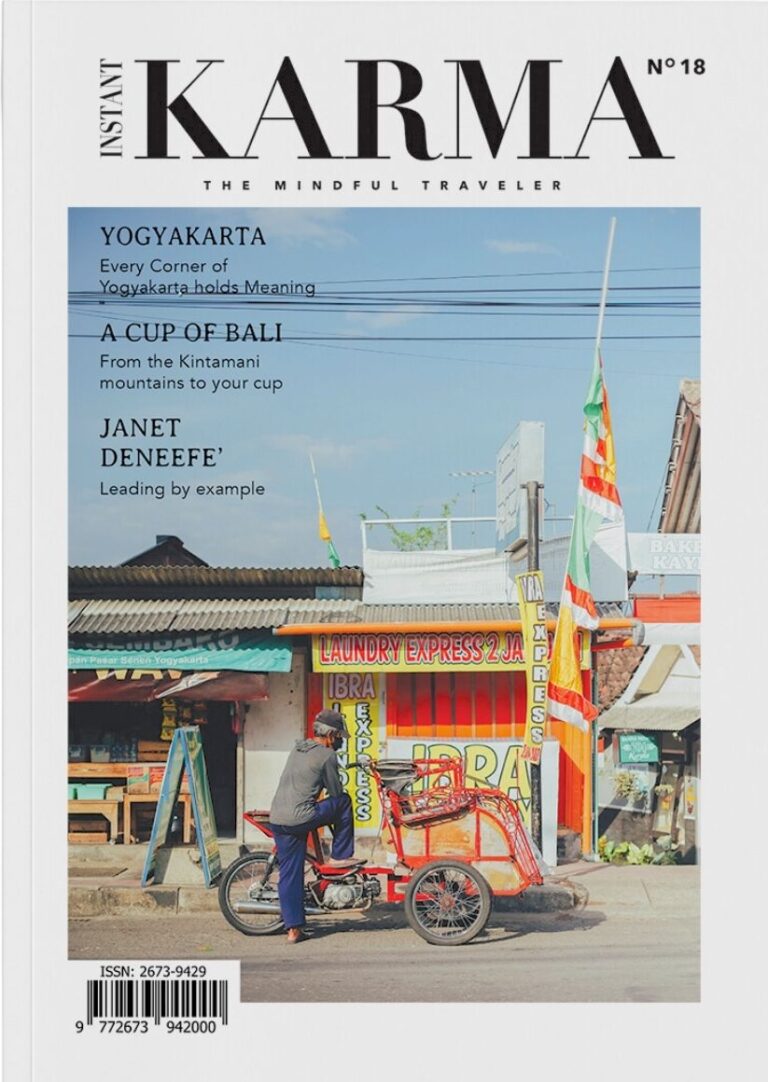Yogyakarta
There is an unshakeable down-to-earth allure to Yogyakarta. Simple yet cultured, smart yet humbled, serene yet somehow also vibrant. The city, recognized as the Special Region of Yogyakarta, is renowned for many things—its wondrous temples, natural scenery, culinary delights, education, and its preserved monarch known as Kraton—and is probably the second most popular place to visit after Bali. But mind you, it’s a different creature altogether.
For starters, Yogyakarta has a quaint, almost village vibe. Avid fans of the old-school bicycle sepeda onthel still roam the streets with the sound kring kring heralding their presence. And another transport blast from the past, the becak (cycle rickshaw), beckons you to climb up and take an open-air city tour.
You can sit and dine on the matted floor of food vendors colloquially named kaki lima, referring to their five-footed carts (two of the merchant’s legs plus three “legs”, which are actually three wheels, or two wheels and a wooden leg) in the famous Malioboro street. You order nasi kucing, a teeny-tiny portion of rice, chicken, tempeh, and veggies, washed down with their (super) sweet tea or, if at night, the ginger-based drink wedang ronde, to warm the body.
Then you may wish to visit the royal complex, a reminder of the Javanese stronghold of the past. Time may flow, but they remain steadfast in keeping their traditions. And this is where it all started, as the city was born from the creation of the Kraton.
As immortalized by Katon Bagaskara’s hit ballad, Yogyakarta; “Every corner greets you in a friendly manner/ deep with meaning / I am suddenly swept with nostalgia / When we make time / to enjoy together / the scenery of Jogja.”
And that pretty much sums up the essence of Yogyakarta.

Higher Learning
Yogyakarta is known as Kota Pelajar, or Student City. Approximately 20 percent of the population comprises a diverse mix of students from various parts of Indonesia and some from other countries, taking studies ranging from history, art, literature, and economics to computer science and tannery production. There are more than 100 colleges in Yogyakarta, with the oldest being the state university, Universitas Gadjah Mada, which was founded in 1949.
Several sources state how the region grew into an educational center is unclear. However, one can’t overlook the role of one of the city’s renowned figures in helping to shape such reputable status. His name is Ki Hadjar Dewantara, the first Minister of Education and one of Indonesia’s National Heroes. In 1959, he was knighted by President Soekarno as the Father of National Education for his efforts in gaining independence through educational channels.
Dewantara came from royalty, but he strives for equality in education for the people—an opportunity only given to the children of Javanese royal families and Dutch colonialists back in the day. Thus, he established the school Taman Siswa in 1922, which later expanded to other provinces.
His chosen motto for his educational principle is called Tut Wuri Handayani, and they are words to live by: ing ngarso sung tulodo (those in front should set an example), ing madyo mangun karso (those in the middle should raise the spirit), tut wuri handayani (those behind should give encouragement).

A Royal Experience
The royal complex, at first sight, is unassuming. Kraton Jogja rests on a 13-hectare courtyard that houses, among others, several pavilions with specific functions, a mosque, museums (including exhibitions of batik, paintings, and the history of Sultan Hamengkubuwono IX), and the Sultan’s palace. It’s a somewhat breezy yet informative experience and a great place to learn about the Javanese kingdom’s rich history.
Outside the Kraton grounds, you’ll find Taman Sari, a royal garden complex complete with a bathing pool formerly used as a place to unwind by the royal family. Despite the lovely setting, the building was apparently a sort of fortress with tunnels underneath.
For a unique cultural festivity, you should visit the Kraton during the three Muslim holy days: Ramadhan, Idul Adha, and the birth of the Prophet Muhammad. A ceremonial procession that feels almost militaristic marches out of the Sultan’s palace; soldiers and abdi dalem (custodians of the royal households) carry conical-shaped offerings called gunungan to the mosque Masjid Gedhe.
There are seven in total, led by gunungan kakung (male) and gunungan estri (female), and they are stacked high with ketan (sticky rice), cakes, vegetables, and fruits—all tied on a bamboo stick. Things get a bit chaotic at the procession’s last destination as people frantically try to grab the most food from the stack. It is believed that the more they get, the more blessings they receive. The ritual is a form of gratitude for nature’s harvest and also symbolizes the Sultan’s offerings to his people.
Keeping Up with the Times
Since 2019, an annual exhibition has been held twice a year at the Kraton. Each year different themes are highlighted, and for 2023 they’ve chosen the theme “Kraton, Nature, and Continuity”. The first exhibition of the year, held every March – September, usually brings up topics that center on Kraton-related objects; the second exhibition, from October to December, relates to figures of the Kraton.
As part of their effort to move with the times, the Kraton Jogja has an official Instagram account (@KratonJogja) and a YouTube channel that posts activities and programs happening on the premise. So be sure to check them out.
The Tree Provides
As we mentioned before, the city’s environment is serene yet vibrant. The vibrancy is perfectly exemplified by Malioboro Street—a vibrant and bustling area not only to dine but to shop as well. You can find here casual attires mixed in with batik and handicrafts vendors. It’s a bit touristic, but it’s the easiest spot to feel the atmosphere of the city.
Another popular shopping site is Pasar Beringharjo, which has existed since the 1700s. Here you’ll find a more complete collection of batik, vintage items, a dedicated floor for jamu (a traditional herbal drink) as well as the spices the drink is made of, and even more local food. The market may look “modern”—no longer open space like your normal traditional market—but it is rooted in the city’s initial development as it’s part of the expansion to the north of the Kraton that centers on economic activities.
The name itself is a portmanteau of the word bering (the sacred banyan tree that occupies the once empty land), and harjo (welfare), the underlying meaning being the tree is expected to provide welfare for the city’s people.
Sweet Life
Nasi kucing (literally translates to cat food) is not the culinary emblem of Yogyakarta. It’s a variation of the nasi campur (mixed rice) but with a far miniature portion. Jogja’s signature dish is gudeg, made from young jackfruit steeped in palm sugar and santan or coconut milk. Mind you, it’s sweet (as the people of Central Java like their food and drinks to taste), but it is delicious. The dish is synonymous with Yogyakarta, giving another moniker to the city: Kota Gudeg.
There are many places that offer gudeg in Yogyakarta—including at Malioboro—but for a more authentic taste, try Gudeg Yu Jum Wijilan and Gudeg Permata as they cook from inherited family recipes.
For another sweet delight, bakpia takes the cake. It’s a moon cake, originally with a filling of mung bean paste, but now the fillings are more varied, including chocolate, cheese, and durian. The cake was brought into the region by Chinese traders (with meat filling), and now has become a favorite delicacy for visitors to take home. Many shops sell bakpia, the popular one being Bakpia Pathok. Still, you can also buy straight from the home industries that make them. Just ask a becak driver, and they will take you to one.
Spiritual Sighting
Of course, just like in Bali, we couldn’t talk about Yogyakarta without mentioning the temples. The majestic Candi Borobudur, the biggest Buddhist temple in the world, is the main draw: a sight to behold that will make you wonder how they were able to make this before the advent of heavy machinery.
The UNESCO World Heritage Site was built during the Buddhist Syailendra dynasty that once ruled the land in the 8-9th century. It has a roundabout architecture where you go in clockwise, starting from four lower square platforms that lead to three circular ones that are supposed to represent the ascension of Buddha towards enlightenment. It’s a pilgrimage site that many Buddhists visit on Vaisak, including monks from Thailand who walk from their home country to Borobudur on foot.
Geographically, Candi Borobudur is actually Yogyakarta-adjacent—located in the town of Magelang to the south of Jogja, nestled within beautiful verdant surroundings. Near Borobudur, there are smaller Buddhist temples, Mendut and Pawon, and all three are considered interconnected pilgrimage routes of the past as they are located on a straight line.
Another must-see temple is the Hindu temple of Prambanan, around 17km northeast of Jogja, built around the same time as Borobudur. Here the temples are spread out into six major ones. Three temples represent the three gods of Hindu: Brahma the Creator, Vishnu the Preserver, and Shiva the Destroyer; while the other three that lie opposite them represent their respective vehicles (vahana), the garuda, bull, and swan. It is seen as a temple built to honor Shiva as the god of destruction has the tallest temple (47 meters).
Prambanan is the biggest Hindu temple in Indonesia and second-largest to Angkor Wat. A major attraction on site is the Sendratari Ramayana show. This theatrical dance performance tells the story of Rama and Sitta from the Ramayana epic (as depicted on the reliefs of the temple). The show is held twice a year: on an open-air stage in May-October; and indoors during the rainy season on January-April and November-December.
It’s easy to simply take endless pics (especially with Mount Merapi as a backdrop in the distance) or TikTok your way into the temples, but please also take time to get to know the story of the temple. You can do this by asking for a guide to take you through all the steps and explain the history of these excellent historical sites.








